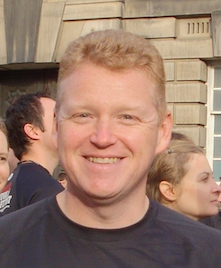
It is with great sadness that we report the death of Mark Peggie, Head of the MRC PPU’s cloning team for many years, who died suddenly on January 17th 2023 at the age of 54.

Mark obtained a B.Sc. in Molecular Biology at the University of Aberdeen and also completed a PhD degree at Aberdeen, before moving to Dundee to carry out postdoctoral research in Biological Sciences. He then spent three years in Michael Stark’s laboratory in the Division of Gene Regulation and Expression at Dundee, where he worked on chromosome stability and the nuclear localisation of protein phosphatase 1 (PP1) using yeast as a model system [1]. Mark joined the MRC PPU in 2001. He initially worked with Maria Deak to provide support in DNA cloning for the Unit’s research teams. A year later the cloning team was expanded to also provide support for the Division of Signal Transduction Therapy (DSTT), a collaboration between the Unit and six of the world’s largest pharmaceutical companies. Rachel Toth and Nicola Wood also joined the DNA cloning team at this time.
Mark was instrumental in widening the DNA cloning service to offer support to other Divisions in the School of Life Sciences and he also completed a Master’s in Business Administration (MBA) at this time. Later, Mark and Rachel widened the DNA cloning service to help academics and companies worldwide as part of the MRC PPU’s Reagents and Services laboratory. The massive contribution made by Mark may be gauged by the 12,000 clones he made, and by the inclusion of his name on countless methods, PCR machine programmes and other reagents and publications.
Mark was a co-author on over 60 of the Unit’s published papers between 2002 and 2017. For example, Miratul Muqit recalls that Mark made a key contribution to early studies showing that the Parkin E3 ligase activity was regulated by PINK1-dependent phosphorylation, a key step in the process of mitophagy. Miratul also recalled that “He made a vast number of Parkin cDNA constructs that enabled elaboration of the first substrate-based assay of Parkin [2], and that uncovered the mechanism of how PINK1-phosphorylates ubiquitin to allosterically activate Parkin [3]. Mark also generated a critical series of cDNA constructs encoding PINK1 from Tribolium castaneum that led to the first high resolution X-ray crystal structure of PINK1 providing fundamental understanding of how PINK1 mutations cause Parkinson’s disease by disrupting the kinase domain [4]”. Mark was a co-author on 30 of Tricia and Philip Cohen’s papers between 2002 and 2017, which included papers about a then newly discovered protein phosphatase (PP4) (eg [5]), the first paper describing activation of a tRNA modifying enzyme by a protein kinase [6] and the first description of an E3 ubiquitin ligase activated by a protein kinase [7].

Mark had an enormous heart and generous spirit and would help anyone who needed a hand with something. Since his death, many people have spoken to Rachel Toth of his kindness to them at one time or another, both in a professional and a personal capacity. On a night out with the cloning team he would never leave anyone behind and on one famous occasion came to the rescue of team member Zoe Gage, who had lost both her shoes and the keys to her flat. He was always first on the dance floor, often in his kilt with sporran shifted to the side and flinging everyone about with abandon. For Mark loved his home country fiercely, never missing an opportunity to preach the pro-Scottish Independence message (and often sporting a T-shirt with a pro-Independence slogan under his lab coat!).
Mark had a great sense of humour and had time for everyone. As one lab member said to Rachel, “He had good banter, and could take the banter too”. On one occasion, he and Rachel pretended to do some telemarketing using one of the Art installations in the LifeSpace area.
Mark was hospitable and generous, frequently throwing BBQs at his home, where he was a devoted husband to Janet and father to Freya. His joy when Janet gave birth to Freya was clear for all to see.
Mark was a keen runner, completing in the Edinburgh marathon and encouraging others in the cloning team to join him in a 10 kilometre obstacle race in Edinburgh called ‘Survival of the Fittest’.
An abiding memory is of Mark heaving Rachel out of an inflatable box on the Royal Mile in Edinburgh, as she had been rendered useless by a fit of the giggles. Mark embraced life and to know him meant to be welcomed into that with kindness. He will be sorely missed by many.
Rachel Toth and Philip Cohen
References
1.Peggie, M.W. et al (2002) J. Cell Sci. PMID:11801737
Essential functions of Sds22p in chromosome stability and nuclear localization of PP1
2. Kazlauskaite A, et al: Open Biol. 2014. PMID: 24647965
3. Kazlauskaite A, et al. EMBO Rep. 2015. PMID: 26116755
4.Kumar A, et al. Among authors: Elife. 2017. PMID: 28980524
Structure of PINK1 and mechanisms of Parkinson's disease-associated mutations.
5. Carnegie GK, et al.: J Cell Sci. 2003. PMID: 12668731
6. Cartlidge RA, et al.: EMBO J. 2005. PMID: 15861136
The tRNA methylase METTL1 is phosphorylated and inactivated by PKB and RSK in vitro and in cells.
7. Ordureau A, et al.: Biochem J. 2008. PMID: 17997719

